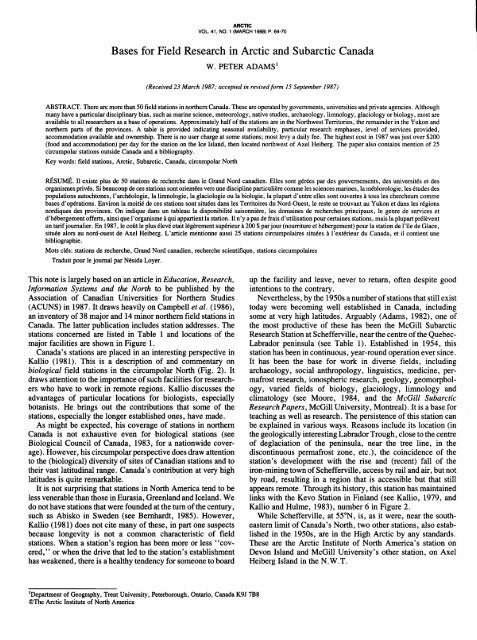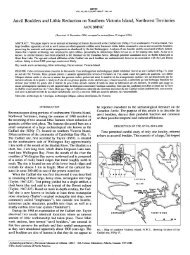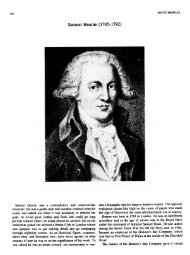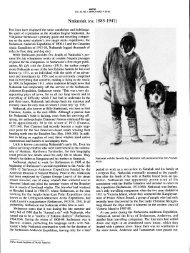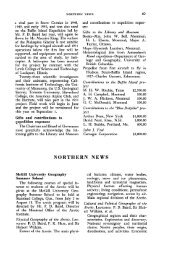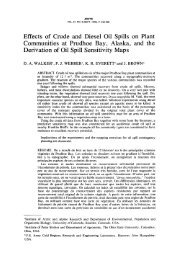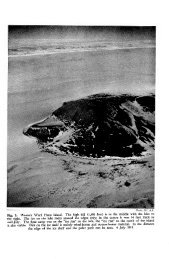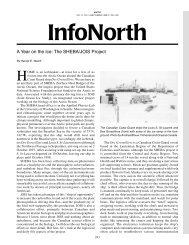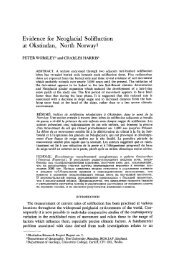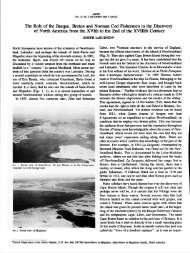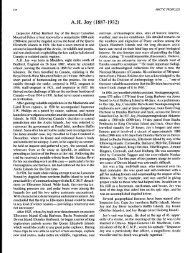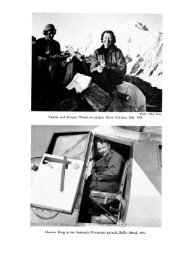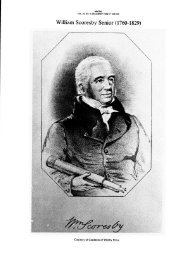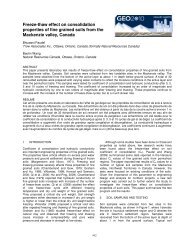Bases for Field Research in Arctic and Subarctic Canada - AINA ...
Bases for Field Research in Arctic and Subarctic Canada - AINA ...
Bases for Field Research in Arctic and Subarctic Canada - AINA ...
Create successful ePaper yourself
Turn your PDF publications into a flip-book with our unique Google optimized e-Paper software.
ARCTIC<br />
VOL. 41, NO. 1 (MARCH 1988) P. 64-70<br />
<strong>Bases</strong> <strong>for</strong> <strong>Field</strong> <strong>Research</strong> <strong>in</strong> <strong>Arctic</strong> <strong>and</strong> <strong>Subarctic</strong> <strong>Canada</strong><br />
W. PETER ADAMS’<br />
(Received 23 March 1987; accepted <strong>in</strong> revised <strong>for</strong>m 15 September 1987)<br />
ABSTRACT. There are more than 50 field stations <strong>in</strong> northern <strong>Canada</strong>. These are operated by governments, universities <strong>and</strong> private agencies. Although<br />
many have a particular discipl<strong>in</strong>ary bias, such as mar<strong>in</strong>e science, meteorology, native studies, archaeology, limnology, glaciology or biology, most are<br />
available to all researchers as a base of operations. Approximately half of the stations are <strong>in</strong> the Northwest Territories, the rema<strong>in</strong>der <strong>in</strong> the Yukon <strong>and</strong><br />
northern parts of the prov<strong>in</strong>ces. A table is provided <strong>in</strong>dicat<strong>in</strong>g seasonal availability, particular research emphases, level of services provided,<br />
accommodation available <strong>and</strong> ownership. There no is user charge at some stations; most levy a daily fee. The highest cost <strong>in</strong> 1987 was just over $200<br />
(food <strong>and</strong> accommodation) per day <strong>for</strong> the station on the Ice Isl<strong>and</strong>, then located northwest of Axel Heiberg. The paper also conta<strong>in</strong>s mention of 25<br />
circumpolar stations outside <strong>Canada</strong> <strong>and</strong> a bibliography.<br />
Key words: field stations, <strong>Arctic</strong>, <strong>Subarctic</strong>, <strong>Canada</strong>, circumpolar North<br />
&SUME. I1 existe plus de 50 stations de recherche dans le Gr<strong>and</strong> Nord canadien. Elles sont gkrkes par des gouvernements, des universitks et des<br />
organismes privbs. Si beaucoup de ces stations sont orientbes vers une discipl<strong>in</strong>e particulilrre comme les sciences mar<strong>in</strong>es, la m&korologie, les k<br />
populations autochtones, I’archbologie, la limnologie, la glaciologie ou la biologie, la plupart d’entre elles sont ouvertes B tous les chercheurs comme<br />
bases d’op6rations. Environ la moitik de ces stations sont situkes dans les Territoires du Nord-Ouest, le reste se trouvant au Yukon et dans les rkgions<br />
nordiques des prov<strong>in</strong>ces. On <strong>in</strong>dique dans un tableau la disponibilitk saisonnitre, les doma<strong>in</strong>es de recherches pr<strong>in</strong>cipaux, le genre de services et<br />
d’hkbergement offerts, a<strong>in</strong>si que I’organisme B qui appartient la station. I1 n’y a pas de frais d’utilisation pour certa<strong>in</strong>es stations, mais la plupart prkllrvent<br />
un tarif journalier. En 1987, le coat le plus klevk etait lkglrrement sup6rieur B 200 $par jour (nourriture et hkbergement) pour la station l’ile de Glace,<br />
situke alors au nord-ouest de Axel Heiberg. L’article mentionne aussi 25 stations circumpolaires situkes B I’extkrieur du <strong>Canada</strong>, et il contient une<br />
bibliographie.<br />
Mots clks: stations de recherche, Gr<strong>and</strong> Nord canadien, recherche scientifique, stations circumpolaires<br />
Traduit pour le journal par Nbsida Loyer.<br />
This note is largely based on article an <strong>in</strong> Education, <strong>Research</strong>,<br />
In<strong>for</strong>mation Systems ana‘ the North to be published by the<br />
Association of Canadian Universities <strong>for</strong> Northern Studies<br />
(ACUNS) <strong>in</strong> 1987. It draws heavily on Campbell et al. (1986),<br />
an <strong>in</strong>ventory of 38 major <strong>and</strong> 14 m<strong>in</strong>or northern field stations <strong>in</strong><br />
<strong>Canada</strong>. The latter publication <strong>in</strong>cludes station addresses. The<br />
stations concerned are listed <strong>in</strong> Table 1 <strong>and</strong> locations of the<br />
major facilities are shown <strong>in</strong> Figure 1.<br />
<strong>Canada</strong>’s stations are placed <strong>in</strong> an <strong>in</strong>terest<strong>in</strong>g perspective <strong>in</strong><br />
Kallio (198 1). This is a description of <strong>and</strong> commentary on<br />
biological field stations <strong>in</strong> the circumpolar North (Fig. 2). It<br />
draws attention to the importance of such facilities <strong>for</strong> researchers<br />
who have to work <strong>in</strong> remote regions. Kallio discusses the<br />
advantages of particular locations <strong>for</strong> biologists, especially<br />
botanists. He br<strong>in</strong>gs out the contributions that some of the<br />
stations, especially the longer established ones, have made.<br />
As might be expected, his coverage of stations <strong>in</strong> northern<br />
<strong>Canada</strong> is not exhaustive even <strong>for</strong> biological stations (see<br />
Biological Council of <strong>Canada</strong>, 1983, <strong>for</strong> a nationwide coverage).<br />
However, his Circumpolar perspective does draw attention<br />
to the (biological) diversity of sites of Canadian stations <strong>and</strong> to<br />
their vast latitud<strong>in</strong>al range. <strong>Canada</strong>’s contribution at very high<br />
latitudes is quite remarkable.<br />
It is not surpris<strong>in</strong>g that stations <strong>in</strong> North America tend to be<br />
less venerable than those Eurasia, <strong>in</strong> Greenl<strong>and</strong> <strong>and</strong> Icel<strong>and</strong>. We<br />
do not have stations that were founded at the turn of the century,<br />
such as Abisko <strong>in</strong> Sweden (see Bernhardt, 1985). However,<br />
Kallio (1981) does not cite many of these, <strong>in</strong> part one suspects<br />
because longevity is not a common characteristic of field<br />
stations. When a station’s region has been more or less “covered,”<br />
or when the drive that led to the station’s establishment<br />
has weakened, there is a healthy tendency <strong>for</strong> someone to board<br />
‘Department of Geography, Trent University, Peterborough, Ontario, <strong>Canada</strong> K9J 7B8<br />
@The <strong>Arctic</strong> Institute of North America<br />
up the facility <strong>and</strong> leave, never to return, often despite good<br />
<strong>in</strong>tentions to the contrary.<br />
Nevertheless, by the 1950s a number of stations that still exist<br />
today were becom<strong>in</strong>g well established <strong>in</strong> <strong>Canada</strong>, <strong>in</strong>clud<strong>in</strong>g<br />
some at very high latitudes. Arguably (Adams, 1982), one of<br />
the most productive of these has been the McGill <strong>Subarctic</strong><br />
<strong>Research</strong> Station at Schefferville, near the centre of the Quebec-<br />
Labrador pen<strong>in</strong>sula (see Table 1). Established <strong>in</strong> 1954, this<br />
station has been <strong>in</strong> cont<strong>in</strong>uous, year-round operation ever s<strong>in</strong>ce.<br />
It has been the base <strong>for</strong> work <strong>in</strong> diverse fields, <strong>in</strong>clud<strong>in</strong>g<br />
archaeology, social anthropology, l<strong>in</strong>guistics, medic<strong>in</strong>e, permafrost<br />
research, ionospheric research, geology, geomorphology,<br />
varied fields of biology, glaciology, limnology <strong>and</strong><br />
climatology (see Moore, 1984, <strong>and</strong> the McGill <strong>Subarctic</strong><br />
<strong>Research</strong> Papers, McGill University, Montreal). It is a base <strong>for</strong><br />
teach<strong>in</strong>g as well as research. The persistence of this station can<br />
be expla<strong>in</strong>ed <strong>in</strong> various ways. Reasons <strong>in</strong>clude its location (<strong>in</strong><br />
the geologically <strong>in</strong>terest<strong>in</strong>g Labrador Trough, close to the centre<br />
of deglaciation of the pen<strong>in</strong>sula, near the tree l<strong>in</strong>e, <strong>in</strong> the<br />
discont<strong>in</strong>uous permafrost zone, etc.), the co<strong>in</strong>cidence of the<br />
station’s development with the rise <strong>and</strong> (recent) fall of the<br />
iron-m<strong>in</strong><strong>in</strong>g town of Schefferville, access by rail <strong>and</strong> air, but not<br />
by road, result<strong>in</strong>g <strong>in</strong> a region that is accessible but that still<br />
appears remote. Through its history, this station has ma<strong>in</strong>ta<strong>in</strong>ed<br />
l<strong>in</strong>ks with the Kevo Station <strong>in</strong> F<strong>in</strong>l<strong>and</strong> (see Kallio, 1979, <strong>and</strong><br />
Kallio <strong>and</strong> Hulme, 1983), number 6 <strong>in</strong> Figure 2.<br />
While Schefferville, at SON, is, as it were, near the southeastern<br />
limit of <strong>Canada</strong>’s North, two other stations, also established<br />
<strong>in</strong> the 1950s, are <strong>in</strong> the High <strong>Arctic</strong> by any st<strong>and</strong>ards.<br />
These are the <strong>Arctic</strong> Institute of North America’s station on<br />
Devon Isl<strong>and</strong> <strong>and</strong> McGill University’s other station, on Axel<br />
Heiberg Isl<strong>and</strong> <strong>in</strong> the N.W.T.
TABLE 1. <strong>Canada</strong>'s northern field stations<br />
Northwest Territories<br />
1 Adams Isl<strong>and</strong>, 74N, 81W (A.R.E.')<br />
2 Alex<strong>and</strong>ra Fiord Post (R.C.M.P.), 79 N, 76W<br />
3 <strong>Arctic</strong> Biological Station - <strong>Field</strong> Camp, 64N, 69W<br />
4 <strong>Arctic</strong> Ice Isl<strong>and</strong> (PCSP), 81N, 97W (mov<strong>in</strong>g)<br />
5 <strong>Arctic</strong> <strong>Research</strong> Establishment, 73N, 78W<br />
6 Borden Station, 74N, 81W (A.R.E.')<br />
7 Chitty Lake <strong>Field</strong> Station, 61N, 114W<br />
8 Coates Isl<strong>and</strong>, 63N, 83W<br />
9 Devon Isl<strong>and</strong> <strong>Research</strong> Station, 76N, 85W<br />
10 Eastern <strong>Arctic</strong> Scientific Resource Centre, 69N, 82W<br />
11 Eskimo Po<strong>in</strong>t <strong>Arctic</strong> <strong>Research</strong> Centre, 61N, 94W<br />
12 Eureka Aerological Station, 80N, 86W<br />
13 Ikaluit <strong>Research</strong> Laboratory, 64N, 69W<br />
14 McGill Axel Heiberg Station, 79N, 91W<br />
15 Mould Bay Aerological Station, 76N, 119W<br />
16 Nauyuk Lake <strong>Field</strong> Station, 68N, 108W<br />
17 Nunguvik <strong>Arctic</strong> Centennial Station, 74N, 81W<br />
18 Pearce Po<strong>in</strong>t <strong>Field</strong> Station, 70N, 123W<br />
19 Polar Bear Pass High <strong>Arctic</strong> <strong>Research</strong> Stn., 76N, 98W<br />
20 Resolute Bay <strong>Field</strong> Station, 75N, 95W<br />
21 Resolute Station (PCSP) 75N, 95W<br />
22 Saqvaqjuac <strong>Field</strong> Station, 64N, 91W<br />
23 Sarcpa Lake <strong>Field</strong> Station, 69N, 83W<br />
24 Tuktoyaktuk <strong>Field</strong> Station, 69N, 133W<br />
25 Tuktoyaktuk Station (PCSP), 69N, 133W<br />
26 Western <strong>Arctic</strong> Scientific Resource Ctre, 68N, 134W<br />
Yukon Temtory<br />
27 Kluane Lake <strong>Research</strong> Station, 61N, 139W<br />
Newfoundl<strong>and</strong>/Labrador<br />
28 Labrador Institute of Northern Studies, 53N, 60W<br />
Quebec<br />
29 Kuujjuaq <strong>Research</strong> Centre, 58N, 68W<br />
30 Kuujjuaq <strong>Research</strong> Station, 58N, 68W<br />
31 Kuujjuarapik <strong>Research</strong> Station, 55N, 78W<br />
32 McGill <strong>Subarctic</strong> <strong>Research</strong> Station, 55N, 67W<br />
Manitoba<br />
33 Churchill Northern Studies Centre, 58N, 94W<br />
34 Institute of <strong>Arctic</strong> Ecophysiology, 58N, 94W<br />
35 Southern Indian Lake <strong>Research</strong> Station, 56N, 98W<br />
36 Tundra Biological Station, 59N, 93W<br />
Saskatchewan<br />
37 Cree Lake Aerological Station, 57N, 107W<br />
Alberta<br />
38 Mildred Lake Environmental <strong>Research</strong> Camp, 57N, 11<br />
'Addresses from page <strong>in</strong>dicated <strong>in</strong> Carnpbell'et al. (1986).<br />
'A.R.E. = <strong>Arctic</strong> <strong>Research</strong> Establishment.<br />
Type (Typ): I = year-round teach<strong>in</strong>g <strong>and</strong>/or research.<br />
I1 = seasonal teach<strong>in</strong>g <strong>and</strong>/or research.<br />
NOTE I 65<br />
TYP Man Hab Aff Fac Acm Avb Page<br />
I1<br />
I1<br />
I<br />
I1<br />
I<br />
I<br />
I1<br />
I1<br />
I1<br />
I<br />
I1<br />
I<br />
I<br />
I1<br />
I<br />
I1<br />
I1<br />
I1<br />
WI)<br />
I1<br />
I1<br />
I1<br />
I1<br />
IUI)<br />
I1<br />
I<br />
I<br />
I<br />
I<br />
I1<br />
I<br />
I<br />
I<br />
I<br />
I<br />
I1<br />
I<br />
1w I<br />
F,C<br />
G<br />
F<br />
F,E,C<br />
C<br />
F,C<br />
F<br />
W<br />
G<br />
G<br />
G<br />
0<br />
G<br />
E<br />
0<br />
F<br />
C<br />
G<br />
G<br />
F<br />
G<br />
F<br />
G<br />
F<br />
G<br />
G<br />
G<br />
G<br />
F,W,H<br />
G<br />
G<br />
G<br />
G<br />
G<br />
F<br />
G<br />
0<br />
0<br />
p,u<br />
F<br />
F<br />
0<br />
F,O<br />
F<br />
P<br />
U<br />
F<br />
U<br />
F<br />
F<br />
U<br />
F<br />
F<br />
0<br />
F<br />
F<br />
F<br />
F<br />
F<br />
F<br />
F<br />
F<br />
F<br />
U<br />
U<br />
N<br />
U<br />
U<br />
U<br />
0<br />
U<br />
F<br />
U<br />
F<br />
1<br />
1<br />
2<br />
1<br />
0<br />
1<br />
1<br />
1<br />
2<br />
2<br />
2<br />
1<br />
2<br />
1<br />
1<br />
2<br />
1<br />
2<br />
1<br />
3<br />
2<br />
2<br />
1<br />
3<br />
2<br />
3<br />
0<br />
0<br />
2<br />
3<br />
3<br />
3<br />
0<br />
3<br />
2<br />
1<br />
C P 3 2 2 26<br />
M<strong>and</strong>ate (Man): F = fisheries, W = wildlife, E = earth sciences, H = human sciences, C = physicalkhemical, G = general, 0 = other.<br />
Habitat (Hab): 0 = mar<strong>in</strong>e, W = freshwater, F = <strong>for</strong>est, B = boreal, T = tundra, I = isl<strong>and</strong>, G = glacial.<br />
Affiliation (Aff): F = federal, P = prov<strong>in</strong>cial or territorial, U = university, N = native organization, 0 = other.<br />
Accommodation (Acm): 0 = not available, 1 = 1-10, 2 = 11-20, 3 = greater than 20.<br />
Facilities (Fac): 0 = not available, I = m<strong>in</strong>imal, 2 = fair, 3 = extensive.<br />
Availability (Avb): 0 = closed, I = restricted, 2 = open with some restrictions, 3 = oped<br />
The Devon Isl<strong>and</strong> Station (<strong>AINA</strong>, 1981) was established as a<br />
glaciological-oceanographic station, with additional studies <strong>in</strong><br />
geology <strong>and</strong> geomorphology. In more recent years, however, it<br />
has also become a major focus <strong>for</strong> varied biological <strong>and</strong> soils<br />
work, especially that stemm<strong>in</strong>g from the Truelove Lowl<strong>and</strong>, an<br />
official International Biological Program study site. It is also a<br />
base <strong>for</strong> tra<strong>in</strong><strong>in</strong>g students who live <strong>in</strong> the North. This is now<br />
essentially a summer facility, although parties have overw<strong>in</strong>tered<br />
there. For an early description of the station, see Ragle<br />
(1974); <strong>for</strong> an overview of IBP work, see Bliss (1977).<br />
The Axel Heiberg Station was established by the late Fritz<br />
1<br />
2<br />
2<br />
3<br />
3<br />
2<br />
1<br />
1<br />
1<br />
3<br />
2<br />
1<br />
3<br />
1<br />
1<br />
1<br />
1<br />
2<br />
1<br />
3<br />
3<br />
2<br />
2<br />
2<br />
3<br />
3<br />
3<br />
3<br />
3<br />
1<br />
1<br />
2<br />
3<br />
2<br />
2<br />
1<br />
1<br />
2<br />
3<br />
0<br />
1<br />
2<br />
2<br />
2<br />
3<br />
3<br />
3<br />
3<br />
2<br />
3<br />
2<br />
2<br />
3<br />
2<br />
3<br />
O(2)<br />
3<br />
3<br />
2<br />
3<br />
2<br />
3<br />
3<br />
Muller (see Adams, 1985, <strong>and</strong> the Axel Heiberg <strong>Research</strong><br />
Report series, McGill University, Montreal) as a base <strong>for</strong><br />
multidiscipl<strong>in</strong>ary research but with a glaciological focus. It is a<br />
summer facility, no one ever hav<strong>in</strong>g overw<strong>in</strong>tered there. A large<br />
amount of glaciological work has been published, plus a great<br />
deal of biological (especially botanical), geological, geomorphological,<br />
climatological <strong>and</strong> limnological work among others.<br />
With<strong>in</strong> easy reach of the station there is a variety of glaciers<br />
(<strong>in</strong>clud<strong>in</strong>g one with more than two decades of mass balance<br />
records, detailed movement statistics <strong>and</strong> thermal data), a<br />
naturally acidified lake <strong>and</strong> sulphur spr<strong>in</strong>gs. A bibliography of<br />
3<br />
2<br />
2<br />
3<br />
3<br />
3<br />
3<br />
3<br />
2<br />
3<br />
2<br />
3<br />
4<br />
5<br />
6<br />
7<br />
8<br />
9<br />
12<br />
13<br />
14<br />
15<br />
16<br />
17<br />
24<br />
27<br />
28<br />
29<br />
30<br />
31<br />
32<br />
33<br />
34<br />
35<br />
37<br />
38<br />
40<br />
19<br />
23<br />
20<br />
21<br />
22<br />
25<br />
10<br />
18<br />
36<br />
39<br />
11
66 I NOTE<br />
FIG. I. Locations of field stations listed <strong>and</strong> numbered <strong>in</strong> Table 1. The shaded area is the lichen-woodl<strong>and</strong> zone of <strong>Canada</strong>. The l<strong>in</strong>e across the country is the southern<br />
limit <strong>for</strong> use of grants under the Northern Scientific Tra<strong>in</strong><strong>in</strong>g Program of Indian <strong>and</strong> Northern Affairs, <strong>Canada</strong>. These grants are used by hundreds of Canadian students<br />
to supplement their northern field expenses (see F<strong>in</strong>kler, 1987).<br />
work from this station now runn<strong>in</strong>g <strong>in</strong>to many hundreds of items (1979),McLean(1982),Oosenbrug(1976),S<strong>in</strong>clairetal. (1982),<br />
is soon to be published by McGill.<br />
Allen (1982); <strong>in</strong> geomorphology, Bourgois (1981), Johnson<br />
At another extremity of <strong>Canada</strong>’s North, <strong>in</strong> the Yukon, the (1980, 1981); <strong>in</strong> geophysics <strong>and</strong> glaciology, Clarke (1975,<br />
University of Calgary’s <strong>Arctic</strong> Institute of North America ma<strong>in</strong>- 1982); <strong>in</strong> atmosphere sciences, Holdsworth (1983); <strong>in</strong> physita<strong>in</strong>s<br />
its station on Kluane Lake. is a This very sophisticated, year- ology, Houston (1976a,b) <strong>and</strong> Sutton (1977); <strong>in</strong> sedimentologyround<br />
facility at the foot of the St. Elias Mounta<strong>in</strong>s. It provides limnology,Bryan(1971);<strong>in</strong>plann<strong>in</strong>g,Cottre11(1975). Areview<br />
access to a wide range of biological habitats <strong>and</strong> physical environ- of early work at the station can be found <strong>in</strong> de la Barre (1977).<br />
ments from ice fields to boreal <strong>for</strong>est. It has been the base <strong>for</strong> very All of the above are university stations. In the northwestern<br />
varied biological <strong>and</strong> human physiological research, glaciology “comer” of the Canadian North is the Western <strong>Arctic</strong> Scientific<br />
(<strong>in</strong>clud<strong>in</strong>g recent surg<strong>in</strong>g glacierwork), archaeology, eng<strong>in</strong>eer<strong>in</strong>g Resource Centre located Inuvik, <strong>in</strong> beside the Mackenzie Delta.<br />
<strong>and</strong> limnology (see <strong>AINA</strong>, 1983). It can be reached via the Alaska This is an example of a different type of station, one of three<br />
Highway <strong>and</strong> has its own aircraft. An <strong>in</strong>dication of the range of well-equipped, year-round facilities operated by the Departactivities<br />
at this station, <strong>and</strong> of the scope <strong>for</strong> future work, can be ment of Indian <strong>and</strong> Northern Affairs of the federal government.<br />
ga<strong>in</strong>ed by scann<strong>in</strong>g the follow<strong>in</strong>g sample publications: <strong>in</strong> biology, The others <strong>in</strong> this group are the Iqaluit <strong>Research</strong> Laboratory<br />
Bout<strong>in</strong> (1982), Gilbert <strong>and</strong> Krebs (1981), Hannon (1982), Hoefs (Iqaluit was <strong>for</strong>merly Frobisher Bay) <strong>and</strong> the Eastern <strong>Arctic</strong>
NOTE I 67<br />
FIG. 2. Locations of major biological, especially botanical, stations <strong>in</strong> circumpolar the North from Kallio (1981). The shaded area is the “subarctic” woodl<strong>and</strong> zone<br />
between the tundra <strong>and</strong> the boreal <strong>for</strong>est. There is some tendency <strong>for</strong> be stations located <strong>in</strong> to zones of rapid transition - on vegetational boundaries, rivers <strong>and</strong> coasts.<br />
From west to east, beg<strong>in</strong>n<strong>in</strong>g <strong>in</strong> Sc<strong>and</strong><strong>in</strong>avia, these stations are: (1) Forsheim, (2) Abisko, (3) Tromso, (4).Kilpisjpi, (5) Rovaniemi, (6) Kevo, (7) V ~ O (8) ,<br />
Oulanka, (9) Chib<strong>in</strong>, (10) Sivaya Maska, (11) Salekhard, (12) Agapa, (13) Tareya, (14) Ary-Mas, (15) Mana Pronchtsheva Bay, (16) Thi, (17) Abongen, (18)<br />
Magadan-Sneznaya dol<strong>in</strong>e, (19) Pokhodsk, (20) Ust-Chaun, (21) Wrangel Isl<strong>and</strong>s, (22) Anadyr, (23) Bmw,.(24) Kluane Lake,,(25) Inuvik, (26) Tuktoye, (27)<br />
Churchill, (28) Rank<strong>in</strong> Inlet, (29) Axel Heiberg Isl<strong>and</strong>, (30) Devon Isl<strong>and</strong>, (31) IglooWr, (32) Poste-de-la Baleme, (33) Scheffervllle, (34) Kuujjuaq, (35) Iqalmt, (36)<br />
Disko, (37) My Alesund.
68 / NOTE<br />
Scientific Resource Centre at Igloolik. A number of small report each year that <strong>in</strong>cludes a publications list. Current work<br />
outpost stations are associated with these facilities. Theresources <strong>in</strong>cludes lemm<strong>in</strong>g biology (e.g., Barker et al., 1982), goose <strong>and</strong><br />
of the Inuvik Station provide a good <strong>in</strong>dication of those at the other bird research (e.g., Bazely <strong>and</strong> Jefferies, 1983), polar bear<br />
others. It has fully equipped chemistry-soils-biology laborato- research (e.g., Ramsay, 1982), microclimatology <strong>and</strong> climatolries,<br />
cold rooms, libraries, visitors’ office, greenhouses, etc., ogy (e.g., Rouse, 1982a,b; Rouse <strong>and</strong> Bello, 1983) <strong>and</strong> w<strong>in</strong>d<br />
with a sizable year-round staff <strong>and</strong> good transportation facili- energy research (e.g., Chappell, 1983).<br />
ties. The work at each station, naturally, varies with the nature Churchill can be reached by tra<strong>in</strong> as well as by air. In its<br />
of the region. Bibliographies of work completed are available vic<strong>in</strong>ity there are two other stations, the Institute of <strong>Arctic</strong><br />
(e.g., Castonguay <strong>and</strong> Sherstone, 1985). The best central source Ecophysiology <strong>and</strong> the Tundra Biological Station. The <strong>for</strong>mer is<br />
of <strong>in</strong><strong>for</strong>mation on these stations is the Circumpolar <strong>and</strong> Scien- affiliated with the University of Manitoba; Laurentian Univertific<br />
Affairs Directorate of the Department of Indian <strong>and</strong> North- sity, Ontario; <strong>and</strong> the University of Oslo, Norway. It is a base<br />
ern Affairs (Ottawa, <strong>Canada</strong> K1A OH4). A variety of detailed <strong>for</strong> quantitative research on bears <strong>and</strong> other large arctic wildlife<br />
reports on the stations, <strong>in</strong>clud<strong>in</strong>g a cluster produced <strong>in</strong> the early as well as be<strong>in</strong>g a local education centre. Long-term studies of<br />
1980s, is available. Examples are Lewis (1981), Espie (1980) the beluga whale <strong>and</strong> the raven are under way. Examples of<br />
<strong>and</strong> Rode (1985). The stations are located <strong>in</strong> communities <strong>for</strong> <strong>in</strong>stitute publications are Hurst (1981), Hurst et al. (1987a,b),<br />
which they are important resources.<br />
Watts (1982) <strong>and</strong> Oritsl<strong>and</strong> (1980).<br />
Another very different set of government-operated facilities The Tundra Station is particularly well known <strong>for</strong> its bird,<br />
is the five stations of the Freshwater Institute, W<strong>in</strong>nipeg. These notably geese <strong>and</strong> duck, studies. This research has attracted<br />
are Sagvaqjuac (near Chesterfield Inlet), Southern Indian Lake national <strong>and</strong> <strong>in</strong>ternational acclaim. A very limited selection of<br />
(northern Manitoba), the Resolute Bay Station (South Camp, the work concerned is Cooke <strong>and</strong> Harmsen (1983), Cook et al.<br />
Resolute), Chitty Lake (near Yellowknife) <strong>and</strong> Nauyuk Lake (1983), F<strong>in</strong>dlay <strong>and</strong> Cooke (1983) <strong>and</strong> Geramita <strong>and</strong> Cooke<br />
(Kent Pen<strong>in</strong>sula). They focus on freshwater, with some mar<strong>in</strong>e, (1982).<br />
research with a strong biological focus. They tend to be operated Another <strong>in</strong>terest<strong>in</strong>g “set” with<strong>in</strong> Table 1 is <strong>for</strong>med of three<br />
as seasonal facilities, although Southern Indian Lake runs High <strong>Arctic</strong> aerological stations operated by Atmospheric Enviyear-round<br />
<strong>and</strong> others have been opened <strong>in</strong> w<strong>in</strong>ter. These ronment Service, <strong>Canada</strong> (AES, 1985). These are Cree Lake,<br />
stations have made a remarkable contribution to freshwater <strong>and</strong> Saskatchewan; Eureka, Ellesmere Isl<strong>and</strong>; <strong>and</strong> Mould Bay on<br />
mar<strong>in</strong>e science <strong>in</strong> <strong>Canada</strong>. An <strong>in</strong>dication of this can be ga<strong>in</strong>ed Pr<strong>in</strong>ce Patrick Isl<strong>and</strong>. They are year-round weather stations that<br />
from the special issue of the Canadian Journal ofFisheries <strong>and</strong> can be used, with advance notice, by visit<strong>in</strong>g research workers.<br />
Aquatic Science (1984) devoted to work undertaken from South- Work from these stations is not restricted to studies of weather!<br />
ern Indian Lake station. Another example of a contribution to <strong>Research</strong> of various sorts has been carried out from them s<strong>in</strong>ce<br />
circumpolar fisheries research is Johnson (1983). Yet another is 1946 (see Met. Div., 1951).<br />
the limnological work of Welch (e.g., Welch <strong>and</strong> Bergman, Lastly, an <strong>in</strong>terest<strong>in</strong>g recent addition to the list of <strong>Canada</strong>’s<br />
1985), who is now engaged <strong>in</strong> mar<strong>in</strong>e work at the Resolute field stations is the ice isl<strong>and</strong>, Hobson’s Choice (see, <strong>for</strong><br />
station.<br />
example, Jackson, 1986). This is a piece of shelf ice that, at the<br />
Two <strong>in</strong>terest<strong>in</strong>g non-government stations are <strong>Arctic</strong> <strong>Research</strong> time of writ<strong>in</strong>g, is off the northwest coast of Axel Heiberg<br />
Establishment (Pond Inlet, Baff<strong>in</strong> Isl<strong>and</strong>) <strong>and</strong> the Kuujjuaq Isl<strong>and</strong>, N.W.T. Dur<strong>in</strong>g the next decade or so, it is hoped that it<br />
<strong>Research</strong> Centre (Kuujjuaq, Quebec). The <strong>for</strong>mer is a private will move out <strong>in</strong>to the <strong>Arctic</strong> Ocean <strong>and</strong> do circuits of it. The<br />
operation specializ<strong>in</strong>g <strong>in</strong> physical-biological studies, especially<br />
mar<strong>in</strong>e science (Steltner, 1985), <strong>in</strong>volv<strong>in</strong>g Inuit personnel. The<br />
Polar Cont<strong>in</strong>ental Shelf Project of Energy, M<strong>in</strong>es <strong>and</strong> Resources,<br />
<strong>Canada</strong>, has established a runway <strong>and</strong> e number of build<strong>in</strong>gs on<br />
latter is the field station of Makivik Corporation, <strong>for</strong>merly the it as the base <strong>for</strong> a variety of scientific projects, <strong>in</strong>clud<strong>in</strong>g mar<strong>in</strong>e<br />
Northern Quebec Inuit Association. The Pond Inlet site is <strong>and</strong> ocean floor studies <strong>and</strong> weather. Automated stations on it<br />
especially good <strong>for</strong> work focus<strong>in</strong>g on the High <strong>Arctic</strong> mar<strong>in</strong>e transmit weather <strong>and</strong> seismic data year-round. This is a station<br />
environment. It has a number of outpost stations <strong>for</strong> specific yet to come <strong>in</strong>to its own.<br />
projects. The Kuujjuaq <strong>Research</strong> Centre is particularly con- My purpose here is not to describe all of the field stations <strong>in</strong><br />
cerned with wildlife research <strong>and</strong> management issues of <strong>in</strong>terest<br />
to the local people <strong>in</strong> a region located on the tree l<strong>in</strong>e. Current<br />
work <strong>in</strong>cludes fisheries studies, salmon research <strong>and</strong> work on<br />
northern <strong>Canada</strong> exhaustively. A great deal of <strong>in</strong><strong>for</strong>mation<br />
about the stations can be obta<strong>in</strong>ed from the references - Campbell<br />
et al. (1986) <strong>and</strong> Biological Council of <strong>Canada</strong> (1983) - cited<br />
the eider duck. One of the focuses is the evaluation <strong>and</strong> at the beg<strong>in</strong>n<strong>in</strong>g of this article. My purpose is rather to stimulate<br />
application of Inuit knowledge of the local environment. Sam- the reader to consider how an exist<strong>in</strong>g facility might be of use to<br />
ple publications are Dumas et al. (1984, 1985) <strong>and</strong> Nakashima him or her. The stations are a national resource that tends to be<br />
(1985).<br />
underused. Virtually all stations encourage cooperative, multi-<br />
However, the largest “private” facility <strong>in</strong> <strong>Canada</strong> is the discipl<strong>in</strong>ary, multi-<strong>in</strong>stitutional use, but <strong>in</strong> reality, <strong>for</strong> quite<br />
Churchill Northern Studies Centre at Churchill, Manitoba. It natural reasons, they tend to be identified with certa<strong>in</strong> groups or<br />
can accommodate 50 people (20 <strong>in</strong> w<strong>in</strong>ter). It has well-equipped <strong>in</strong>dividuals so that others tend not to consider them. It should be<br />
laboratories <strong>and</strong> teach<strong>in</strong>g rooms <strong>and</strong> a library. It is the base <strong>for</strong> realized that a station primarily devoted to, say, weather or<br />
credit <strong>and</strong> non-credit courses taught by faculty from various limnology may also be a good base <strong>for</strong>, say, archaeological or<br />
universities <strong>in</strong> <strong>Canada</strong> as well as a base <strong>for</strong> research. The sociological projects. There is enormous scope <strong>for</strong> sav<strong>in</strong>gs <strong>in</strong><br />
location, on the <strong>for</strong>est/tundra transition zone, near the mouth of the cost of northern research through shared use of such facilithe<br />
Churchill River <strong>and</strong> on Hudson Bay, is excellent <strong>for</strong> a ties <strong>and</strong> shared use of transportation to <strong>and</strong> from them. Many<br />
variety of terrestrial <strong>and</strong> aquatic (mar<strong>in</strong>e <strong>and</strong> freshwater) biolog- stations are actively seek<strong>in</strong>g to exp<strong>and</strong> their research horizons;<br />
ical studies, glaciology <strong>and</strong> geomorphology. The area is famous many more would benefit from quite modest, long-term, advance<br />
<strong>for</strong> its polar bear studies. The centre publishes a comprehensive commitments from researchers or teachers. The Natural Sci-
NOTE I 69<br />
ences <strong>and</strong> Eng<strong>in</strong>eer<strong>in</strong>g <strong>Research</strong> Council of <strong>Canada</strong> is already,<br />
through its <strong>in</strong>frastructure grants program, encourag<strong>in</strong>g cooperative<br />
use of such facilities (Lillycrop, 1987). Multiple use has<br />
academic benefits <strong>in</strong> an age when arctic researchers have<br />
<strong>in</strong>creas<strong>in</strong>gly to be aware of developments <strong>in</strong> fields other than<br />
BLISS, L.C., ed. 1977. The Truelove Lowl<strong>and</strong>, Devon Isl<strong>and</strong>, <strong>Canada</strong>, a high<br />
arctic ecosystem. University of Alaska Press. 714 p.<br />
BOURGOIS, J. 1981. Etude palynologique dans la vallke du Grizzly Creek,<br />
(Yukon). M.A. Thesis, University of Ottawa. 85 p.<br />
BOUTIN, S.A. 1982. Factors affect<strong>in</strong>g dispersal <strong>and</strong> juvenile survival <strong>in</strong><br />
snowshoe hares. Ph.D. Thesis, University of British Columbia.<br />
their own.<br />
Stations are of particular value as bases <strong>for</strong> teach<strong>in</strong>g programs.<br />
Some - <strong>for</strong> example, the Labrador Institute <strong>in</strong> Goose<br />
Bay, Labrador - regard teach<strong>in</strong>g of local <strong>and</strong> “southern”<br />
students as their pr<strong>in</strong>cipal function. The field stations located <strong>in</strong><br />
communities are especially good <strong>for</strong> teach<strong>in</strong>g. They allow<br />
northerners <strong>and</strong> southerners to meet, work <strong>and</strong> learn together.<br />
Stations are also good bases <strong>for</strong> those, notably students, undertak<strong>in</strong>g<br />
research projects <strong>in</strong> the North <strong>for</strong> the first time.<br />
<strong>Field</strong>work <strong>in</strong> the North is expensive, but costs of accommodation<br />
<strong>in</strong> these stations are not prohibitive. Some can be used<br />
free of charge; others will provide a schedule of fees. In 1987<br />
there were stations that charged as little as $30 (Canadian) per<br />
day, <strong>in</strong>clud<strong>in</strong>g food. The highest daily cost, aga<strong>in</strong> <strong>in</strong>clud<strong>in</strong>g<br />
food, was over $200 per day on the Ice Isl<strong>and</strong>. Even this last is<br />
not expensive <strong>in</strong> comparison to hotels <strong>in</strong> the South or North.<br />
Costs without meals were, of course, lower. Many stations will<br />
make special arrangements <strong>for</strong> groups <strong>and</strong> will provide advice<br />
BRYAN, M.L. 1971. Sedimentation <strong>in</strong> glacially-fed Kluane Lake, Yukon<br />
Temtory. Ph.D. Thesis, Department of Geography, The University of<br />
Michigan, Ann Arbor. 203 p.<br />
CAMPBELL, G.T., ADAMS, W.P., <strong>and</strong> FINKLER, H. 1986. <strong>Canada</strong>’s Northern<br />
Stations. ACUNS Occasional Publication No. 13. 44 p.<br />
CANADIAN JOURNAL OF FISHERIES AND AQUATIC SCIENCE. 1984.<br />
Southern Indian Lake Impoundment <strong>and</strong> Churchill River Diversion. 41(4).<br />
CASTONGUAY, R., <strong>and</strong> SHERSTONE, D. 1985. Bibliography of research<br />
publications, Inuvik Scientific Resource Centre 1964-1984. Office of Northern<br />
<strong>Research</strong> <strong>and</strong> Science Advisor, Indiana <strong>and</strong> Northern Affairs <strong>Canada</strong>. 87<br />
CHAPPELL, MS. 1983. Some current activities <strong>in</strong> the Canadian W<strong>in</strong>d Energy<br />
Program, W<strong>in</strong>dEnergy Technical Memor<strong>and</strong>um, Divisionof Energy, National<br />
<strong>Research</strong> Council of <strong>Canada</strong> No. 22774.<br />
CLARKE, G.K.C. 1975. Surg<strong>in</strong>g glacier studies. Canadian Alp<strong>in</strong>e Journal<br />
58:38.<br />
-. 1982. The 1978 outburst flood from “Hazard Lake”, Yukon Temtory<br />
<strong>and</strong> the problem of flood magnitude prediction. Journal of Glaciology<br />
28~3-21.<br />
COOKE, F., <strong>and</strong> HARMSEN, R. 1983. Does sex ratio vary with egg sequence<br />
<strong>in</strong> Lesser Snow Geese? Auk 100:215-217.<br />
COOKE, F., FINDLAY, C.S., <strong>and</strong> ROCKWELL, R.F. 1983. Life history<br />
studies of the Lesser Snow Goose. 2. Colony structure. Behavioural Ecology<br />
on transportation <strong>in</strong> <strong>and</strong> out <strong>and</strong> <strong>in</strong> the local area.<br />
<strong>and</strong> Sociobiology 12:153-159.<br />
No field station is an end itself. <strong>in</strong> The worth of each can only COTTRELL, J.T. 1975. An evaluation of the national park plann<strong>in</strong>g process<br />
with implications <strong>for</strong> wildlife: A case study of Kluane National Park. M.A.<br />
be measured <strong>in</strong> terms of work undertaken <strong>and</strong> experience ga<strong>in</strong>ed Thesis, School of Urban <strong>and</strong> Regional Plann<strong>in</strong>g, University of Waterloo.<br />
there. <strong>Canada</strong> has a f<strong>in</strong>e network of stations that is often DE LA BARRE, 1977. The Icefield Ranges <strong>Research</strong> Project, 1975 <strong>and</strong> 1976.<br />
neglected by our northern teach<strong>in</strong>g <strong>and</strong> research community. <strong>Arctic</strong> 30(2):130-132.<br />
DUMAS, R., GORDON, A.H., <strong>and</strong> KONEAK, M. 1984. Biological characteristics<br />
of the Atlantic salmon catch from the Whale River, 1983. Kuujjuaq:<br />
ACKNOWLEDGEMENTS<br />
M<strong>in</strong>isere du Loisirs de la Chase et de la Wches. 11 p.<br />
I am most grateful to the late Gordon T. Campbell <strong>for</strong> his work on the<br />
<strong>in</strong>ventory, which is the basis of this note, <strong>and</strong> to Hugh French <strong>and</strong><br />
Jocelyn Lillycrop <strong>for</strong> <strong>in</strong><strong>for</strong>mation on field stations abroad.<br />
DUMAS, R., GORDON, A.H., GORDONA, A.S., <strong>and</strong> KONEAK, M. 1985.<br />
The Koksoak River Fishery 1984. Kuujjuaq: Groupe d’Etudes Conjo<strong>in</strong>t<br />
Kaniapiscau-Koksoak. 56 p.<br />
ESPIE, T. 1980. The Inuvik Science <strong>Research</strong> Centre, an assessment, work<strong>in</strong>g<br />
draft. Indian <strong>and</strong> Northern Affairs, <strong>Canada</strong>. 30 p.<br />
FINDLAY, C.S., <strong>and</strong> COOKE, F. 1983. Genetic <strong>and</strong> environmental compo-<br />
REFERENCES<br />
nents of clutch size variance <strong>in</strong> the Lesser Snow Goose. Evolution 37:724-73<br />
FINKLER, H. 1987. The Northern Scientific Tra<strong>in</strong><strong>in</strong>g Program: A Program to<br />
ADAMS, W.P. 19‘82. Twenty-five years of subarctic research. The Musk-ox Support University Development of Scientific Expertise <strong>in</strong> <strong>Canada</strong>’s North.<br />
30:75-80.<br />
In: Adams, W.P., ed. Education, <strong>Research</strong>, In<strong>for</strong>mation Systems <strong>and</strong> the<br />
- 1985. The McGill Station on Axel Heiberg Isl<strong>and</strong>. Polar Record North. Ottawa: ACUNS. 66-71.<br />
341-343.<br />
GERAMITA, J., <strong>and</strong> COOKE, F. 1982. Evidence that fidelity to natal breed<strong>in</strong>g<br />
AES. 1985. High <strong>Arctic</strong> Weather Stations (HAWS), Aide Memoire, Central colony is not absolute <strong>in</strong> female snow geese. Canadian Journal of Zoology<br />
Region, Atmospheric Environment Service, <strong>Canada</strong>.<br />
60~2051-2056.<br />
<strong>AINA</strong>. 1981. Report on the <strong>Arctic</strong> Institute of North America’s Devon Isl<strong>and</strong> GILBERT, B.S., <strong>and</strong>KREBS, C.J. 1981. Effectsofextrafoodonf‘eromyscus<br />
<strong>Research</strong> Station, NWT. Calgary: <strong>Arctic</strong> Institute of North America, Univer- <strong>and</strong> Clerhrionomys populations <strong>in</strong> the southern Yukon. Oecologia 51:326-331.<br />
sity of Calgary. With bibliography.<br />
HANNON, S. 1982. Female aggressiveness, breed<strong>in</strong>g density, <strong>and</strong> monogamy<br />
-. 1983. History <strong>and</strong> status of the Kluane Lake <strong>Research</strong> Station, Yukon. <strong>in</strong> willow ptarmigan. Ph.D. Thesis, University of British Columbia.<br />
Calgary: <strong>Arctic</strong> Institute of North America, University of Calgary. 33 p. HOEFS, M. 1979. Ecological <strong>in</strong>vestigation of a population of Dall sheep (Ovis<br />
<strong>in</strong>clud<strong>in</strong>g bibliography.<br />
dulli dulli Nelson). Syesis 12 (Sppl. 1):l-81.<br />
ALLEN, H.D. 1982. Dendrochronological studies <strong>in</strong> the Slims River Valley, HOLDSWORTH, G. 1983. A 100-yrrecordof volcanic pollution, tropospheric<br />
Yukon Territory. M.Sc. Thesis, University of Calgary, Calgary, Alberta. chemistry <strong>and</strong> climatic change <strong>in</strong> the Yukon. Paper presented 34th Alaska<br />
179 p.<br />
Science Conference, Whitehorse.<br />
BARKER, I.K., MALLORY, F.F., <strong>and</strong> BROOKS, R.J. 1982. Spontaneous HOUSTON, C.S. 1976a. High Altitude Illness. Journal of American Medical<br />
gastric squamous cell carc<strong>in</strong>omas <strong>and</strong> other neoplasms <strong>in</strong> Greenl<strong>and</strong> collared Association 236(19):2193-2195.<br />
lemm<strong>in</strong>gs (Discrosionyx groenlundicus). Canadian Journal of Comparative -. 1976. The <strong>Arctic</strong> Institute High Altitude Physiology Study. American<br />
Medic<strong>in</strong>e 46(3):307-313.<br />
Alp<strong>in</strong>e Joumal20(2):416-428.<br />
BAZELY, D.R., <strong>and</strong> JEFFERIES, R.L. 1983. The effects of graz<strong>in</strong>g by lesser HURST, R.J. 1981. Thermal <strong>and</strong> energetic consequences of oil contam<strong>in</strong>ation<br />
snow geese on the vegetation of an arctic salt-marsh. Report to Canadian on polar bears. M.Sc. Thesis, University of Ottawa. 112 p.<br />
Wildlife Service, Environment <strong>Canada</strong>. 42 p.<br />
BERNHARDT, C.G. 1985. Abiski Nahuvetenskapliga Station, Gungl. Veten-<br />
-9 LEONARD, M.L., WATTS, P.D., BECKERTON, P., <strong>and</strong> ORITS-<br />
LAND, N.A. 1982a. Polar bear locomotion: body temperature <strong>and</strong> energetic<br />
skapsakademien, In<strong>for</strong>mationsavdeln<strong>in</strong>gen, Box 5005, 104 05 Stockholm, cost. Canadian Journal of Zoology W40-44.<br />
Sweden. (Published by the sponsor of the station, the Swedish Academy of<br />
Sciences, to mark its anniversary.)<br />
BIOLOGICAL COUNCIL OF CANADA. 1983. Directory of Canadian <strong>Field</strong><br />
HURST, R.J., ORITSLAND, N.A., <strong>and</strong> WATTS, P.D. 1982b. Body mass<br />
temperature <strong>and</strong> cost of walk<strong>in</strong>g <strong>in</strong> polar bears. Acta Physiologica Sc<strong>and</strong><strong>in</strong>avia<br />
115:391-395.<br />
<strong>Research</strong> Stations, Department of Biology. Carleton University, Ottawa, JACKSON, R. 1986. Ice isl<strong>and</strong> lab. shows petroleum potential. GEOS 15(2):<br />
Ontario KlS 5B6.<br />
1-4. Energy, M<strong>in</strong>es <strong>and</strong> Resources <strong>Canada</strong>.
NOTE I 70<br />
JOHNSON, L. 1983. Homeostatic characteristics of s<strong>in</strong>gle species fish stocks <strong>in</strong> ORITSLAND, N.A. 1980. Physiological functions pert<strong>in</strong>ent to modell<strong>in</strong>g<br />
<strong>Arctic</strong> lakes. Canadian Journal of Fisheries <strong>and</strong> Aquatic Science energy balance at the population level. Proceed<strong>in</strong>gs of the Second Interna-<br />
40(7):987-1024.<br />
tional Re<strong>in</strong>deedcaribou Symposium, Roros, Norway. 350-354.<br />
JOHNSON, P.G. 198 1. The structure of a talus derived rock glacier as deduced RAGLE, J.C. 1974. Scientific depth study of <strong>Arctic</strong> oasis. CanadianGeographfrom<br />
its hydrology. Canadian Journal of Earth Sciences 18(9):1422-1430. ical Journal89(5):4- 11.<br />
-. 1980. Glacier-rock glacier transition <strong>in</strong> the southwest Yukon Territory. RAMSAY, M.A. 1982. Reproductive biology <strong>and</strong> ecology of female polar<br />
<strong>Arctic</strong> <strong>and</strong> Alp<strong>in</strong>e Resarch 12(2):195-204.<br />
bears <strong>in</strong> western Hudson Bay. Naturaliste canadien 109:941-946.<br />
KALLIO, P. 1979. Programmes of the Kevo Station. Holarctic Ecology RODE, A. 1985. Ukpikjuaq, the Eastern <strong>Arctic</strong> Scientific <strong>Research</strong> Centre,<br />
(Copenhagen) 2:279-283.<br />
-. 1981. Facilities <strong>for</strong> botanical research <strong>in</strong> the circumpolar arcticsubarcticzone.<br />
Fennia 159(1):111-119.<br />
- <strong>and</strong> HULME, H. 1983. National <strong>and</strong> <strong>in</strong>ternational cooperation at<br />
the Kevo <strong>Subarctic</strong> Station, F<strong>in</strong>nish Lapl<strong>and</strong>. GeoJournal7(4)353-359.<br />
Igloolik, N.W.T., Annual Report 1983-84, with bibliography. Indian <strong>and</strong><br />
Northern Affairs <strong>Canada</strong>.<br />
ROUSE, W.R. 1982a. Microclimate of law <strong>Arctic</strong> tundra <strong>and</strong> <strong>for</strong>est at Churchill,<br />
Manitoba. Proceed<strong>in</strong>gs of 4th Canadian Permafrost Conference. 68-80.<br />
-. 1982b. The water balance of upl<strong>and</strong> tundra <strong>in</strong> the Hudson Bay lowl<strong>and</strong>s<br />
LEWIS, C.P. 1981. Reports on the Yellowknife Laboratory <strong>and</strong> the Iqaluit<br />
<strong>Research</strong> Laboratory (Frobisher) - work<strong>in</strong>g draft. Northern Social <strong>Research</strong><br />
- measured <strong>and</strong> modelled. Naturaliste canadien 109:457-467.<br />
-<strong>and</strong> BELLO, R.L. 1983. The radiation balance of typical terra<strong>in</strong> units <strong>in</strong><br />
Division, Indian <strong>and</strong> Northern Affairs <strong>Canada</strong>. 22 p.<br />
low <strong>Arctic</strong>. Annals of the Association of American Geographers<br />
LILLYCROP, J. 1987. The Natural Sciences <strong>and</strong> Eng<strong>in</strong>eer<strong>in</strong>g <strong>Research</strong> Coun- 73(4):538-549.<br />
cil of <strong>Canada</strong>. In: Adams, W.P., ed. Education, <strong>Research</strong>, In<strong>for</strong>mation<br />
Systems <strong>and</strong> the North. Ottawa: ACUNS. 76-77.<br />
SINCLAIR, A.R.E., KREBS, C.J., <strong>and</strong> SMITH, J.N.M. 1982. Diet qualit)<br />
<strong>and</strong> food limitations <strong>in</strong> herbivores: The of case the snowshoe hare. Canadian<br />
McLEAN, I.G. 1982. The association of female k<strong>in</strong> <strong>in</strong> the arctic ground squirrel Journal of Zoology 605389-897.<br />
Spermophilus parryi. Behavioral Ecology <strong>and</strong> Sociobiology 1091-99. STELTNER, H.A.R. 1985. A Progress Report on the <strong>Arctic</strong> <strong>Research</strong> Estab-<br />
MET. DIV. 1951(?). Meteorological Division, Department of Transport,<br />
lishment’s Activities, Its Programs, Projects, <strong>and</strong> Ma<strong>in</strong> Experiments as of<br />
<strong>Canada</strong>4.S. Weather Bureau, Department of Commerce, Jo<strong>in</strong>t <strong>Arctic</strong> March <strong>and</strong> Cover<strong>in</strong>g the Previous 12 years. Northern Eng<strong>in</strong>eer<strong>in</strong>g: Organiza-<br />
Weather Stations, Five Year Report 1946-51 (<strong>in</strong>cludes lists of research tion <strong>and</strong> Policy with Report of the 1985 Conference. Ottawa: ACUNS.<br />
projects, etc.). 147 p.<br />
71-76.<br />
MOORE, T. 1984. 30th Anniversary Volume, McGill <strong>Subarctic</strong> <strong>Research</strong><br />
Papers, 39. Montreal: McGill University.<br />
SUITON, J.R. 1977. The effect of acute hypoxia on the hormonal response to<br />
exercise. Journal of Applied Physiology 42:587-592.<br />
NAKASHIMA, D.J. 1985. Inuit knowledge of the ecology of the common<br />
eider, Somateria mollissima borealis <strong>in</strong> Northern Qukbec. In: Reed, Aust<strong>in</strong>,<br />
WATTS, P.D. 1982. Mammalian hibernation <strong>and</strong> the oxygen consumption of a<br />
denn<strong>in</strong>g black bear. C<strong>and</strong>. Scient thesis, University of Oslo. 52 p.<br />
ed. Eider Ducks <strong>in</strong> <strong>Canada</strong>. Canadian Wildlife Services, Report Series No. WELCH, H.E., <strong>and</strong> BERGMAN, M.E. 1985. W<strong>in</strong>ter respiration of lakes at<br />
47.<br />
Sagvaqjuac, N.W.T. Canadian Journal of Fisheries <strong>and</strong> Aquatic Science<br />
OOSENBRUG, S.M. 1976. Range relationships <strong>and</strong> population dynamics of<br />
the Burwash-Upl<strong>and</strong>s caribou herd, YukonTemtory. MA. Thesis, University<br />
of Waterloo.<br />
42(3):521-528.


